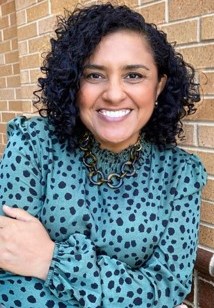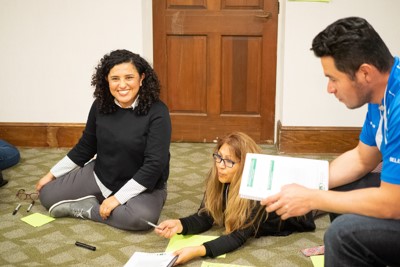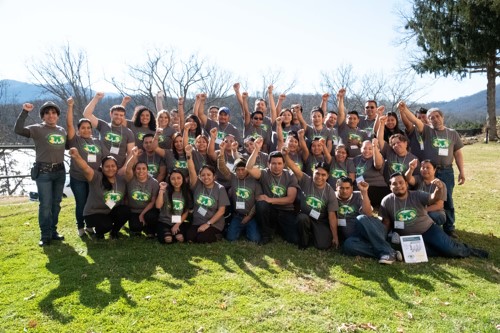Welcome to GCIR's Amplify blog series, where we feature interviews with immigrant justice field leaders to showcase their work and provide a platform for their perspectives. In this edition, GCIR President Marissa Tirona speaks with Magaly Urdiales, Co-executive Director of the Western North Carolina Workers' Center. Read on as Magaly shares her insights on organizing workers in her region, the innovative strategies they use to identify campaign issues and effect the changes workers want to see, and the important role philanthropy can play in building immigrant worker power and leadership in rural areas.
Let’s start with who you are. Please tell us about yourself, your organization, and the communities you serve.
I am the Co-executive Director of the Western North Carolina Workers’ Center, where we build power among workers of color through organizing, education, and direct action. We promote worker justice using an intersectional point of view where we consider the interconnected realities that workers are facing based on the various life experiences and social identities of each person. I have a background as a community organizer and in 2006 began working with nonprofits to create spaces and organizations that amplify and dignify immigrant leaders. I am also a Co-founder of JMPROTV where we, among many other things, produce community media and serve as a bridge between our community and different organizations, services, and resources that exist in the area.Our work starts with building a base, and that looks like connecting with people in neighborhoods and workplaces to grow leadership across diverse industries. We create worker leadership circles and train our members on worker justice using a model of popular education that we’ve developed. We start by supporting our workers to increase critical consciousness by understanding their basic rights, learning about worker and gender justice, and building community leadership. We build on this by bringing folks together for participatory action research and offering opportunities to grow in their leadership.
We promote systemic change grounded in worker rights through direct actions planned and led by the workers themselves on issues they have identified as important and ripe for action. We aim to move workers through a three-dimensional social justice model that listens to their concerns, addresses their needs, and connects those collective needs to strategies for changing policies.This is not easy work. We have to be consistent, we have to have perseverance, and we have to understand the realities of workers. There are nuanced factors that prevent individual workers from taking action or – for others – move them into action. Everybody wants to change working conditions, and everybody has something specific that motivates them. But those reasons may vary from person to person – we don’t all exist in the same reality. We work to understand and incorporate these diverse realities, and we are proud of this approach and the results of our efforts.
What industries do the worker-leaders in your base work in?
The majority work in the poultry industry. In fact, our organization was founded because of a complaint made by poultry workers in 2002. Our base also includes hotel workers, restaurant workers, construction workers, farm workers, seasonal agricultural workers, and kitchen workers. Some of our workers are in the health industry cleaning hospitals and clinics. Many women have started their own cleaning businesses because of the difficult working conditions and unfair pay practices they have experienced at the hands of employers in that sector.
The percentage of women workers in our leadership circles is large – I’d say 65 percent of the leaders are women. I find that impressive because – as women – our realities and careers are more difficult. These women work at least full time, care for their children, and on top of that they manage to find the time to come together and do something important for the community.We have a program called Mujeres Luchadoras, which began in 2010 as a space for immigrant women to talk about our realities. When I first came to this country, I was so isolated living as an immigrant in such a rural area, but when I found the Workers’ Center, I realized that – even though our families may not be here – we are not alone.
You mentioned the strategy of participatory action research. What does that look like?
At the Workers’ Center, our strategic planning cannot happen without participatory action research. We invite the community, workers from all sectors and industries, to come together to analyze worker realities. Our participatory action research is based on popular education practices and methodology and we map out the needs of workers not only in workplaces, but also in our communities and homes. Based on this mapping, we identify the problems our base will act on.
Then we start prioritizing those problems. That can take a lot of time because we might have a group of 40-60 people, and they all have their own priorities. So we find areas of overlap and opportunities for making change. Depending on the common problems we identify, we propose solutions and start brainstorming campaigns and specific actions.One year, as a result of this research, we developed a campaign for worker access to adequate bathroom breaks. At the time, many of the women workers in the local poultry industry were not getting bathroom breaks when they needed them. This was even more challenging for pregnant women. So this group of women decided to carry out a campaign to change this. We were able to help them in their struggle, but they were the ones to identify what to fight for.
You spoke earlier about your experience coming to a rural area and the isolation of that. Can you speak to the challenges and opportunities that come with building power in rural areas?
For an immigrant woman, the first challenge is not knowing. When I came to North Carolina, living in such a rural and isolated area, I did not know where to go to learn how to navigate systems and connect with resources and different types of people. Not knowing has nothing to do with how much formal education you have. Anyone who goes for the first time to Peru, to India, to Kenya, will need help to understand the rules, the laws, how to move. Sometimes we believe having an academic background will help you to manage and navigate things, but that’s not true. As immigrants, often we don’t know what resources are available and can be scared to ask because we believe that we are foreigners, that this is not our place. For me, the hardest thing was not knowing where to go for answers.A barrier to building power in our community is a lack of a power analysis and a racial equity analysis. When I first arrived and would ask for support, people from this country would most often respond with, “let me connect you with people who can give you food.” This made me so angry. I was not asking for food or looking for charity. I was a teacher with more than 15 years of experience working with elementary school children. I was asking for opportunities to thrive, to bring my leadership, and to build community. And there were many barriers to finding that.
Fortunately for me, one day some people from organizations in the big city came and I was able – for the first time – to meet people with similar histories and was able to share my experiences. They connected me with valuable resources, and I found an opportunity to do something not just for me, but also for my community. This led me to begin working with the Workers’ Center. That changed my life, and I want this organization to do the same for other women.
What do you need philanthropy to do?
If I could really put it out there and say something to philanthropy, it’s that we are not two worlds apart. We are part of one human community. There are amazing people in philanthropy, and I want us to be able to come closer together and understand each other’s realities. Let’s not just meet through written reports or beautiful charts with numbers. Sit with us, have in-person conversations. Jump in. Build real relationships with the groups you are supporting.
If I can offer something, humbly? Over the years I’ve heard funders talk about efforts to put resources in the communities where they are most needed, immigrant communities being one of those. In addition to offering resources, philanthropy can also offer opportunities for people to lead. The part of rural North Carolina where I lived when I first arrived had resources, but the issue was access. The resources intended for my community were managed by white people from this country who didn’t have the same analysis of racial equity and power that someone from another culture has. Philanthropy is about moving resources, yes. But it’s also about making sure leadership opportunities exist for people with lived realities related to where funding is going - people of color - and making sure that these perspectives are represented at the tables where decisions are being made.
Finally, what is your vision for the next 5-7 years?Our vision is to achieve justice for all workers, especially immigrant workers. The collective power we have been building among immigrant workers has been grounded in leadership. Our leadership circles are divided into three committees that focus on investigation, education, and organizing. My vision is that these committees thrive and that the worker-leaders have even greater ownership of the actions they want to take and have the resources they need to sustain that in the long term.
One dream that I have is that the political leaders representing us can break through the fear and initiate a discussion on behalf of immigrant workers. We are a force in the workplace, and we need to start talking about us. Government agencies are not talking about us. When you say the word “immigrant,” the silence is so strong and you can see the fear. You see elected officials who worry about losing power and clout with supporters. One day, my little girl who is seven years old asked me, “Mom, is the word immigrant a bad word?” I was so sad hearing that. I told her, “You should be very proud to be an immigrant.” It makes me realize how much work there is to do in our communities, and how important it is for this country to see our beauty and how much we bring.







